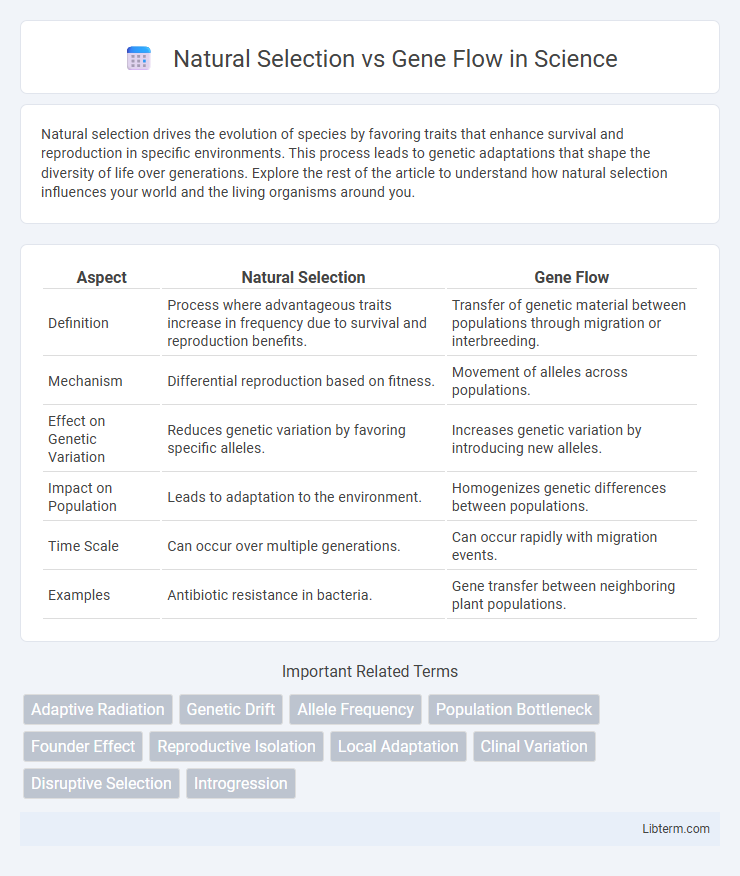Natural selection drives the evolution of species by favoring traits that enhance survival and reproduction in specific environments. This process leads to genetic adaptations that shape the diversity of life over generations. Explore the rest of the article to understand how natural selection influences your world and the living organisms around you.
Table of Comparison
| Aspect | Natural Selection | Gene Flow |
|---|---|---|
| Definition | Process where advantageous traits increase in frequency due to survival and reproduction benefits. | Transfer of genetic material between populations through migration or interbreeding. |
| Mechanism | Differential reproduction based on fitness. | Movement of alleles across populations. |
| Effect on Genetic Variation | Reduces genetic variation by favoring specific alleles. | Increases genetic variation by introducing new alleles. |
| Impact on Population | Leads to adaptation to the environment. | Homogenizes genetic differences between populations. |
| Time Scale | Can occur over multiple generations. | Can occur rapidly with migration events. |
| Examples | Antibiotic resistance in bacteria. | Gene transfer between neighboring plant populations. |
Introduction to Natural Selection and Gene Flow
Natural selection drives evolution by favoring organisms with advantageous traits that enhance survival and reproduction in a specific environment. Gene flow, the transfer of genetic material between populations, increases genetic diversity and can counteract the effects of natural selection by introducing new alleles. Both processes play critical roles in shaping the genetic structure and adaptive potential of populations over time.
Defining Natural Selection: Mechanisms and Examples
Natural selection is the process by which organisms better adapted to their environment tend to survive and produce more offspring, driving evolutionary change. Key mechanisms include variation in traits, differential survival, and reproduction based on those traits, as seen in the peppered moth's color adaptation during the Industrial Revolution. This contrasts with gene flow, which involves the transfer of genetic material between populations, influencing genetic diversity without the selective pressures inherent to natural selection.
Understanding Gene Flow: Meaning and Key Processes
Gene flow refers to the transfer of genetic material between separate populations, increasing genetic diversity within a population and reducing differences between populations. This process occurs through the migration of individuals or the movement of gametes, such as pollen dispersal in plants or animal migration. Understanding gene flow is crucial for studying how populations adapt to environmental changes and maintain genetic health over time.
Differences Between Natural Selection and Gene Flow
Natural selection drives evolutionary change by favoring the survival and reproduction of organisms with advantageous traits, leading to adaptation within a population. Gene flow involves the transfer of genetic material between separate populations, increasing genetic diversity but not necessarily promoting adaptation. While natural selection acts on phenotype to shape population fitness, gene flow primarily alters allele frequencies through migration, often counteracting local adaptation.
How Natural Selection Shapes Populations
Natural selection shapes populations by increasing the frequency of advantageous alleles that enhance survival and reproduction in specific environments. It drives adaptive changes through differential survival, promoting traits that better suit organisms to their ecological niches. Over time, this process leads to the evolution of populations with optimized phenotypic traits, reducing genetic diversity in favor of beneficial genes.
The Role of Gene Flow in Genetic Diversity
Gene flow plays a crucial role in maintaining genetic diversity by introducing new alleles into populations, which can counteract the effects of natural selection and genetic drift. This process enables the exchange of genetic material between populations, reducing the likelihood of inbreeding and increasing adaptability to environmental changes. High rates of gene flow promote genetic variation essential for the survival and evolution of species in dynamic ecosystems.
Interactions Between Natural Selection and Gene Flow
Interactions between natural selection and gene flow shape genetic variation within populations by balancing adaptive traits and allelic exchange. Gene flow introduces new alleles from different populations, potentially reducing local adaptation through natural selection by homogenizing genetic differences. However, strong natural selection can counteract gene flow's effects by favoring alleles best suited for specific environmental conditions, maintaining population differentiation.
Case Studies: Natural Selection vs Gene Flow in Nature
In the Galapagos finches, natural selection drives beak size variation based on seed availability, while gene flow between islands introduces new genetic variants, balancing adaptation and genetic diversity. Similarly, the peppered moth in industrial England exemplifies natural selection favoring camouflage morphs, whereas gene flow from unaffected populations maintains polymorphism. These case studies demonstrate how natural selection shapes local adaptation, whereas gene flow promotes genetic mixing, impacting evolutionary trajectories in wild populations.
Evolutionary Outcomes of Selection and Gene Flow
Natural selection drives evolutionary outcomes by favoring alleles that increase an organism's fitness, resulting in adaptation to local environments and increased population divergence. Gene flow counteracts this process by introducing genetic variation across populations, which can homogenize allele frequencies and reduce local adaptations. The balance between natural selection and gene flow determines the extent of population differentiation and the evolutionary trajectory of species.
Conclusion: Implications for Evolution and Conservation
Natural selection drives adaptive evolution by favoring advantageous traits, while gene flow introduces genetic variation across populations, influencing evolutionary trajectories and resilience. Balancing these forces is crucial for maintaining biodiversity and ecosystem stability, as excessive gene flow may dilute local adaptations, whereas limited gene flow can lead to inbreeding and reduced genetic diversity. Effective conservation strategies must integrate knowledge of both processes to enhance species' evolutionary potential and long-term survival in changing environments.
Natural Selection Infographic

 libterm.com
libterm.com